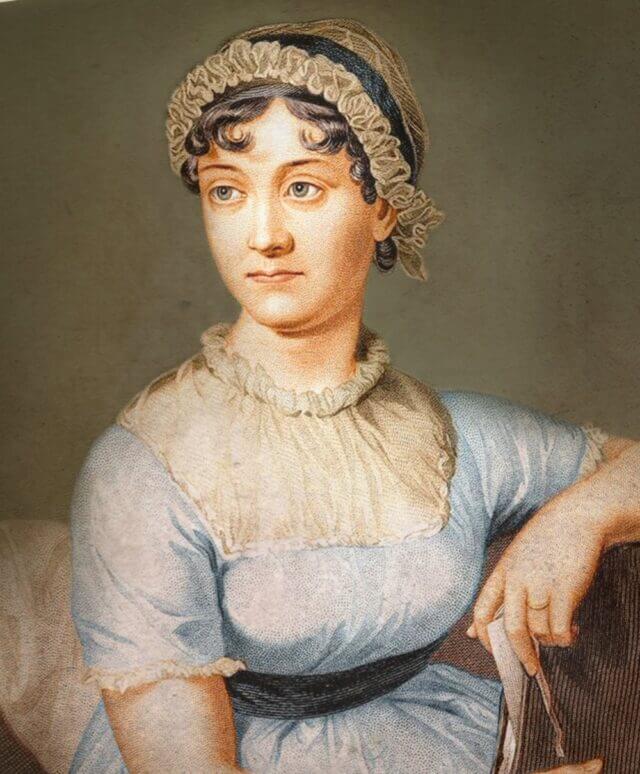Few authors are as beloved—or as misunderstood—as Jane Austen. Born in the closing decades of the 18th century, she lived a life outwardly quiet, domestic, and provincial. Yet within the modest contours of her world, Austen observed the social dynamics of her age with a precision and wit unmatched in English literature. Her six major novels—Sense and Sensibility, Pride and Prejudice, Mansfield Park, Emma, Northanger Abbey, and Persuasion—continue to resonate across centuries, cultures, and continents.
To understand Austen’s novels is to understand Jane Austen the woman: her family, her class, her values, and the unique vantage point from which she surveyed the world. This post offers a detailed exploration of Austen’s life and how it found expression in the enduring fiction that bears her name.

Church of St Nicholas in Steventon, as depicted in A Memoir of Jane Austen by James Edward Austen-Leigh (1869)
Early Life in Steventon
Jane Austen was born on December 16, 1775, in Steventon, Hampshire, the seventh of eight children in a close-knit family. Her father, Reverend George Austen, was the rector of the local Anglican parish and operated a small boarding school for boys out of the rectory. Her mother, Cassandra Leigh Austen, came from a distinguished but financially modest family with clerical and academic ties to Oxford.
Growing up in Steventon Rectory, Austen had access to books, ideas, and a lively household. The Austen family read voraciously, performed amateur theatricals, and encouraged wit and conversation—elements that would all later surface in her fiction. As a girl, Jane was educated primarily at home, first under the guidance of her father and later with her sister Cassandra, to whom she remained deeply devoted throughout her life.
This rural upbringing—surrounded by the rhythms of village life and the peculiarities of the English landed gentry—provided Austen with the social microcosm she would mine for literary gold.
The Juvenilia: A Satirist in the Making
Austen began writing in earnest during her teenage years, producing a remarkable body of juvenilia that showcases her precocious talent for parody and character study. Works like Love and Freindship (note the ironic misspelling) and The History of England lampooned the sentimental novels and pompous historical texts popular at the time.
These early pieces, written largely for the amusement of her family, reveal an already confident voice, one that mocked both literary conventions and the foibles of society. From the outset, Austen was interested not in escapist romance or epic adventure, but in domestic life, social posturing, and moral behaviour—all examined through a sharply ironic lens.
Courtship, Loss, and Independence
Despite writing so extensively about love and marriage, Jane Austen herself never married. That she remained single is not, as is sometimes suggested, evidence of prudishness or disappointment, but rather a reflection of her own values and the financial realities of her time.
In 1802, Austen received a marriage proposal from Harris Bigg-Wither, a family friend. She initially accepted, only to withdraw the next day. Though Bigg-Wither offered security, he did not offer affection or intellectual compatibility—qualities Austen believed essential to marriage. Her decision to reject him, even at the cost of stability, mirrors the convictions of many of her heroines, particularly Elizabeth Bennet in Pride and Prejudice.
Austen’s personal life was also marked by emotional loss. She was deeply affected by the death of her father in 1805, which forced the Austen women into precarious financial circumstances. The years following his death were marked by frequent moves and a lack of permanent residence—a period of personal and creative uncertainty.
Chawton: A Literary Renaissance
A turning point came in 1809, when Austen, her mother, and her sister moved to a cottage in Chawton, Hampshire, provided by her wealthy brother Edward. Chawton offered stability, space, and quiet—ingredients essential to literary productivity.
It was here that Austen revised earlier manuscripts (Sense and Sensibility and Pride and Prejudice) and wrote new works (Mansfield Park, Emma, and Persuasion). She published anonymously—her books appeared under the subtitle “By a Lady”—but her reputation grew rapidly through word of mouth and favourable reviews.
Chawton was not just a sanctuary; it was a crucible in which Austen’s mature style took shape. Her novels from this period reveal a deeper moral complexity, more nuanced characters, and a growing confidence in portraying women’s inner lives.
The World of Jane Austen’s Novels
Austen’s fiction is famously domestic. Her plots rarely leave the English countryside. There are no wars (though the Napoleonic Wars form a backdrop), no Parliament, no colonial adventures. Yet within these quiet settings, Austen interrogated the most pressing issues of her day—inheritance laws, female dependence, class boundaries, and the institution of marriage.
Her novels are peopled by characters with finely drawn social ambitions and economic anxieties. Mr. Darcy’s £10,000 a year, Anne Elliot’s lost bloom at 27, Fanny Price’s poor relations—all these are not incidental details, but narrative engines in a world where one’s future depended on birth, connections, and prudence.
What Austen offered was not escapism but realism, filtered through irony and clarity. Her heroines are often keenly aware of their limited agency. Consider Elinor Dashwood in Sense and Sensibility, who must navigate her emotions within a rigid social framework, or Emma Woodhouse, whose privilege blinds her to the feelings of others until personal growth becomes unavoidable.
Influence of Family and Society
Family life lies at the heart of Austen’s fiction, and her own family strongly influenced her work. Her relationship with her siblings—especially her brothers Edward, Henry, and Charles, who rose in status through adoption, the clergy, and the navy—mirrors the varied fortunes of characters in her novels.
Likewise, her lifelong friendship with Cassandra, and the emotional support they offered one another, can be seen in the close female relationships in her stories: Elizabeth and Jane Bennet, Elinor and Marianne Dashwood, or Anne Elliot and Lady Russell.
Moreover, Austen’s keen sense of social dynamics was honed through decades of careful observation of the gentry class. Her knowledge of inheritance law, for example, is integral to the plot of Pride and Prejudice and Sense and Sensibility, while her understanding of naval life informs Persuasion and Mansfield Park.
Morality and Irony
Austen is not merely a chronicler of drawing-room romances; she is a moralist in the classical sense, concerned with how individuals behave and what they value. Her novels often involve a moral journey, not just a romantic one.
Characters like Marianne Dashwood, Emma Woodhouse, and even Mr. Darcy must confront their own errors before happiness becomes possible. Virtue is not always immediately attractive in Austen’s world—Fanny Price’s morality makes her unpopular with some readers—but it is always ultimately rewarded.
Austen’s use of irony is key to this moral vision. Her narrative voice often maintains a delicate balance between affection and critique, especially when describing her characters’ pretensions, illusions, or self-deceptions. She does not merely present social types; she exposes them.
Illness and Death
In 1816, Austen began to suffer from a mysterious illness—now believed to be Addison’s disease or Hodgkin’s lymphoma. She nonetheless continued to write, completing Persuasion and beginning Sanditon, which remained unfinished at her death.
Jane Austen died on July 18, 1817, at the age of 41. She was buried in Winchester Cathedral, not far from where she had gone to seek medical treatment. Her epitaph makes no mention of her literary achievements—a final reminder of the era’s reluctance to take women’s writing seriously.
Posthumous Fame
After her death, Austen’s reputation grew steadily, particularly after the publication of her nephew James Edward Austen-Leigh’s A Memoir of Jane Austen in 1870, which presented her as a genteel spinster of quiet genius. While this image endured for decades, 20th-century criticism reclaimed Austen as a serious literary figure and proto-feminist thinker.
Today, she is recognized not only for her elegant prose and romantic plots but also for her incisive commentary on class, gender, and morality. Her works have been endlessly adapted, debated, and reinterpreted, from faithful BBC dramas to postmodern pastiches like Clueless and Bridget Jones’s Diary.
A Life Transformed into Art
Jane Austen’s novels endure because they are simultaneously timeless and deeply rooted in their time. Her acute understanding of human nature, her elegant control of form, and her subtle social critique continue to captivate readers across generations.
Her life—a life shaped by limited means, emotional loss, familial devotion, and intellectual independence—found its fullest expression in her art. Austen may have lived quietly, but her voice echoes loudly in the corridors of literary history.
To read Austen is to enter a world at once foreign and familiar, where the turning of a head at a dance, the delay of a letter, or the inheritance of an estate can alter lives. It is to discover, as Austen herself once wrote, that “pictures of perfection... make me sick and wicked,” and that real life—nuanced, flawed, and achingly human—is more than enough.

Experience the world of Jane Austen through scent with our special edition geranium & petitgrain candle inspired by her life. Featuring beautiful hand drawn ink work design by Gisela Gayleard. @gisela_illustrations and https://giselagayleard.com

